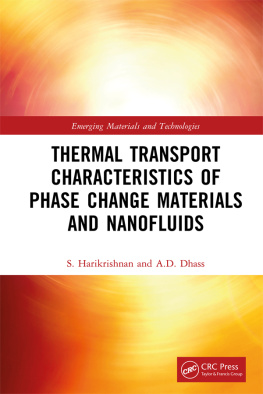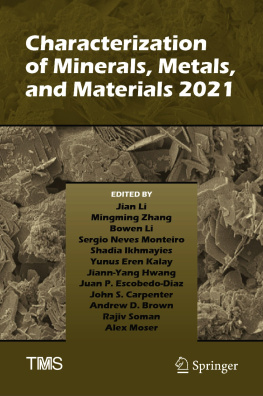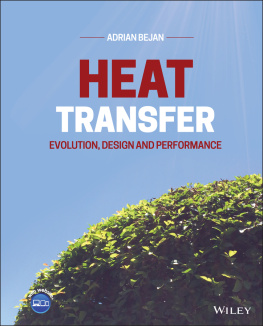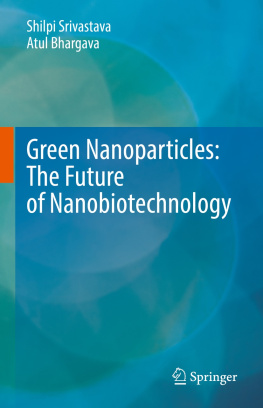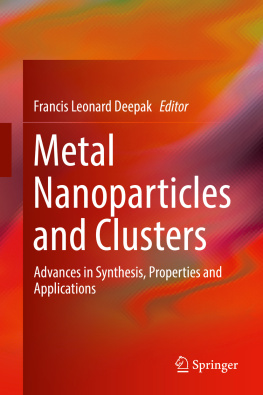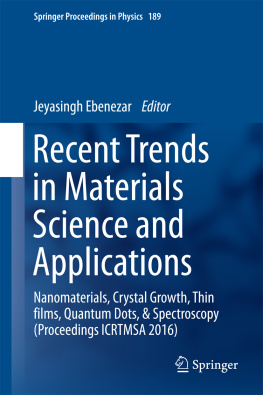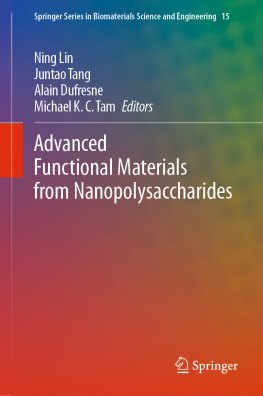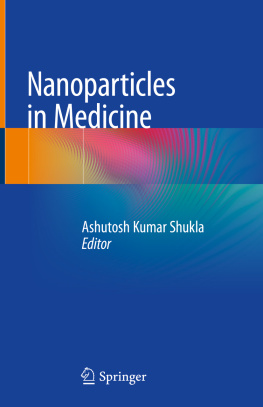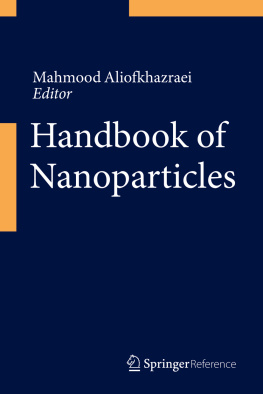Bookmarks
Pagelist
Guide
Acknowledgments
S. Harikrishnan: At the outset, I would like to express my sincere gratitude to Dr.S.Kalaiselvam since I acquired enough knowledge on the phase change materials and nanofluids when I did my research work under his supervision. Next, I am grateful to my father (Mr.E.Santhanam), mother (Mrs.S.Selvambal), wife (Dr.P.Anandhi), and son (Mr.Mohithram), for their never-ending love and support that made me complete this book successfully.
A.D. Dhass: I am grateful to my dear friends Mr.J.N.Bala Ganesh, Mr.T.J.Dorairaj, and my family members including my father (Mr.A.Desappan), mother (Mrs.A.D.Meenakshi), wife (Mrs.P.K.Aparna), daughter (Miss.A.D.Tanishka), and son (Mr.A.D.Jai Krishnan), for their never-ending love and support that made me complete this book successfully.
S. HarikrishnanA.D. Dhass
Introduction
DOI: 10.1201/9781003163633-1
CONTENTS
1.1THERMAL ENERGY STORAGE
Energy demand has increased in several countries and as a consequence of recent advances in energy consumptions. It exacerbates the mismatch between demand and supply in energy, particularly during periods of peak load demand. In order to improve electricity generation it is necessary to establish new conventional generating stations or renewable energy sources (solar, wind, biomass, etc.). Thus, the gap between energy demand and supply may be conduits. But in the case of conventional power stations, they require fossil fuels. A further source of electricity generation is renewable energy, although it is not efficient enough[].
Until an alternative energy source that is cost-effective is found to concentrate on this energy problem, it is critical to make use of the energy that is already accessible and the energy that is stored can be retrieved when it is needed. During sunny days, the heat that is collected can be stored and then used at night in solar energy systems. Buildings in which the requirements for heating are considerable and the cost of electricity enables heat storage to be viable with alternative heating sources can use heat storage. Low melting organic materials are receiving attention for their ability to avoid the difficulties of supercooling and segregation that are associated with inorganic phase change materials[].
Fossil fuel scarcity means that the demand for energy always exceeds the supply, causing an energy crises. When solar energy is efficiently stored in thermal energy storage systems (TES), the problem is to some extent tolerable without harming the environment. Seasonal changes induce an increase in heating demands, which drives up energy usage. Organic phase change materials (PCMs) are more frequently used than inorganic PCMs for their key qualities, with no issue of supercooling, better thermal properties, and chemical stability. Thermal conductivity of organic PCMs is so high that they are not suitable for energy storage or release[].
TES systems are critical for overcoming the energy supply-demand mismatch by managing the interval. The application of the Latent Heat Thermal Energy Storage (LTES) system is controlled by the low thermal conductivity of PCMs in many applications. Due to the PCMs low thermal conductivity, it would be more difficult to store energy and the melting and solidification durations would be longer since heat transfer from the heat transfer fluid (HTF) to the PCM would be slower[].
PCMs were inserted into metal structure heat exchangers to enhance heat transfer performance. It is widely known that metals are better conductors of heat than PCMs in liquid state. Multiple PCMs can also be used to increase energy efficiency in LTES systems rather than using a single PCM. Species with the highest melting points are used in the multiple PCM method. The HTF temperature is kept consistent while charging, even though the flow direction decreases the HTF temperature. While discharging, the HTF flow is directly opposed to charging[].
1.2NANOMATERIALS EMBEDDED PHASE CHANGE MATERIALS
In LTES systems, nanofluids with embedded PCMs contain both base PCMs and solid NPs (nanoparticles). Nanofluid is also known as composite PCM since it is composed of two or more disparate materials (PCMs and solid NPs) combined together. When nanofluids fill a spherical or cylindrical encapsulation and are stored in a storage tank, they tend not to flow in the heat exchange systems[].
NP dispersion in PCM is critical to improving the thermal characteristics of PCM. The Al2O3-H2O nanofluids were found to improve thermal conductivity by 10.5% when 0.2 wt% Al2O3nanoparticles were added to water. Nanoparticles in saturated BaCl2 solution enhanced both the total cool storage and supply by increasing thermal conductivity[].
The conductivity of single nanofluids (CNTs, Au NPs, and Cu NPs) and hybrid nanofluids (CNT-Au NP and CNT-Cu NP) was examined, as were their two different cooling strategies. The thermal conductivity of nanofluid with Cu NPs improved by 74% over the rest, and the thermal conductivity of Cu NP suspension increased in a linear connection with Cu NP concentration. In order to solidify and melt completely, nanofluids will need additional time. When nanoparticles of Ag are combined into and synthesized into 1-tetradecanol (TD), the concentration of nanoparticles of Ag increases with a sample of PCM with better thermal conductivity[].
The thermal conductivity of nanofluids has been found to increase as particle size decreases. Brownian motion of nanoparticles promotes this trend and liquid layering accompanies the movement of nanoparticles. The creation of clusters can increase heat conductivity to some extent, but excessive clustering can have the reverse effect due to the associated sedimentation[].
A buildings cooling system relies on PCMs for the storage of cold energy that is removed from the chilled water system during off-peak hours and returned at peak times. The PCMs used in the LTES system would lower the heat transfer rate. For this reason, the PCMs would retain the cold energy for a longer period of time, which would then interpret into increased electrical energy consumption because of the use of a chilled water system. When it comes to heating systems, PCMs may both store and release heat energy according to the time of day or season. Because of the PCMs low thermal conductivity, the heating unit must run for longer periods of time in order to provide the heat energy, which increases the cost of electricity[].
Solar energy storage is another area of study because it is readily available and can pull in a lot of energy from the solar energy. Its also intermittent, and it relies heavily on the climate conditions. PCMs with high thermal conductivity are preferable for storing solar energy.
1.3PCMS AND SELECTION
A number of approaches have been developed to improve PCM performance, including the use of metal fins, metal meshes and beads, and impregnation of porous materials. Even though these approaches were only minimally effective, they also created more weight and volume for the LTES systems. Recently, the advancement of nanotechnology has led to the creation of a novel approach, known as nanofluids, consisting of both base fluid and solid NPs in varying sizes ranging from 1 nm to 100 nm for the purpose of enhancement in thermal conductivity. It has been established that the optimal strategy for thermal conductivity augmentation is dispersion of solid NPs in the base fluid. Metal NPs, metal oxide NPs, graphene, and carbon nanotubes (CNTs) are used to obtain improved thermal conductivity.
As the PCMs are used to store latent heat, the term latent heat storage materials is often used to refer to them. Thermal energy is transferred when a substance changes from a solid to a liquid or vice versa. This phenomenon is known as a phase change, or a state process. In the beginning, these PCMs are simply regular storage materials as their temperature increases and they are able to absorb heat. In contradiction to conventional (sensible) storage materials, PCMs temperature remains relatively constant while absorbing and releasing heat. Their heat-storage capacity is 5 to 14 times that of sensible materials such as water, masonry, and rock.

